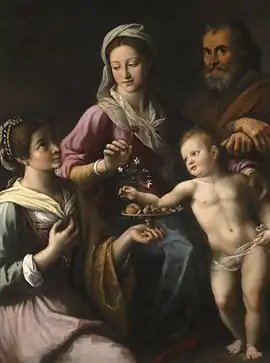Fabrizio Santafede
Fabrizio Santafede or Fabrizio Santaféde (c. 1560–1623/28) was an Italian painter known for his altarpieces. He painted in a late-Mannerist style and his style marks the transition from Mannerism to Baroque.[1][2][3]

Life
Born in Naples, he began as a pupil of his father, the painter Francesco Santafede,[4] and later became a pupil of Marco Pino. He may have been one of the collaborators of Pino on the decoration of the church of S Giovanni Fiorentini in Naples.[3] He traveled extensively, including to Bologna, Florence, Rome, and Venice in his study of the great masters.[5]
He became a dealer in antiques and paintings. He painted extensively in Naples, including an Assumption and Coronation of the Virgin for Santa Donna Regina Nuova. The Baroque painter Massimo Stanzione is mentioned as one of his pupils.
Legend has it that during the sack of Naples in 1647 by insurgents under Masaniello two houses in which Santafede had painted frescos were spared out of respect for the artist.[6]
References
- Sydney J. Freedberg, Painting in Italy 1500-1600; Penguin, 1983, p. 134.
- Freedberg, SJ. p. 356.
- Antonella D’Autilia. "Santafede, Fabrizio." Grove Art Online. Oxford Art Online. Oxford University Press. Web. 14 March 2017
- Giovan Battista Chiarini (a cura di), Delle notizie del bello, dell'antico, e del curioso della città di Napoli raccolte dal canonico Carlo Celano, Vol. I, Napoli, Stamperia Floriana, 1856, p. 154 (in Italian)
- Santaféde, Fabrizio, in: Treccani online (in Italian)
- John Denison Champlin; Charles Callahan Perkins, eds. (1887). Cyclopedia of Painters and Paintings. C. Scribner's sons. p. 112.
External links
 Media related to Fabrizio Santafede at Wikimedia Commons
Media related to Fabrizio Santafede at Wikimedia Commons
Bibliography
- De Dominici, Bernardo (1742). Vite dei Pittori, Scultori, ed Architetti Napolitani, Volume II. Stamperia del Ricciardi, Naples; Digitized by Googlebooks from Oxford University copy on February 1, 2007. pp. 223–236.
- Farquhar, Maria (1855). Ralph Nicholson Wornum (ed.). Biographical catalogue of the principal Italian painters. Woodfall & Kinder, Angel Court, Skinner Street, London; Digitized by Googlebooks from Oxford University copy on Jun 27, 2006. p. 159.
- Wittkower, Rudolf (1993). Pelican History of Art, Art and Architecture Italy, 1600-1750. 1980. Penguin Books.